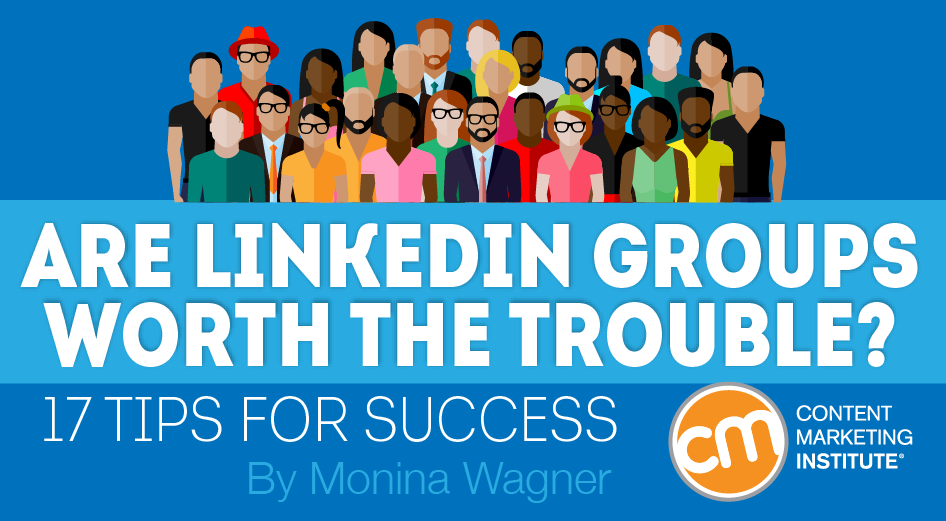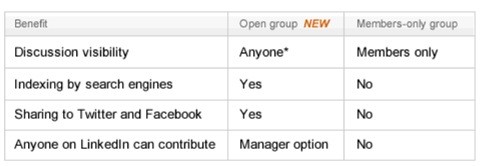If you had access to an audience of 347 million people, would you ignore the opportunity to market to them? Of course, you wouldn’t. LinkedIn continues to be among the most popular social networking sites for professionals. Yet, while the majority of content marketers use LinkedIn, too few rate it as an effective channel.
 To increase LinkedIn’s effectiveness, one beneficial strategy for enterprises is the use of LinkedIn Groups, which connect brands with their audience and often can generate leads for the brand and community members alike.
To increase LinkedIn’s effectiveness, one beneficial strategy for enterprises is the use of LinkedIn Groups, which connect brands with their audience and often can generate leads for the brand and community members alike.
Joe Pulizzi often talks about creating better customers through better marketing. As the community manager for the Content Marketing Institute, I use LinkedIn Groups not only as a way to distribute content, but also as a way to listen to our audience.
It’s critical for brands to understand what their audience members like, what they value, and what they need. Consumers have many options when it comes to where they can network and gain valuable resources. It’s our job to provide access to this information, thus gaining the audience’s trust.
If you are considering starting a LinkedIn group or want to leverage your current group, these tips can help.
Start the right way
Any LinkedIn user can create a group in a matter of minutes. But it is crucial to lay a solid foundation to help ensure the group’s success. Some things to consider:
- Develop a mission statement that distinctly outlines why the group exists to give a clear vision to both potential members and your brand.
- Use targeted keywords in its title and to identify its category so the group can be found in organic search rankings.
- Create clear guidelines and rules.
- Incorporate branding into your group. Use the brand logo in the profile identifier. Consider other visual branded elements as well.
Opt for open or closed
In creating a group, you need to determine if it will be open or members-only. Based on the attributes of both, as shown in this graphic, brands that want to cast a wide net will make their groups open. Brands desiring to promote exclusiveness or wanting an in-house group will select “Members only.” CMI uses both. While we want all content marketers to join the open CMI group, we also have a closed group for the CMI team which is used as a resource for in-house company news and team member communication.
Know your audience
In the Content Marketing Institute LinkedIn group, we start to know our audience by sharing a link with new members so they can introduce themselves in our group guidelines post. For a group to be successful, brands must recognize how their members want to participate. What are they looking for in a group? What would they find most valuable? When in doubt, ask. Seek member opinions, ideas for upcoming posts, and learn what content they would find most relevant. This CMI blog post, How to Find Trained Content Marketing Professionals, happened as a direct result of feedback from our group.
Develop and strengthen your membership
The CMI group engages with thousands of users brought together by the common thread of content marketing. However, we are competing with dozens of other LinkedIn groups geared toward content marketers. In addition, communities on the topic exist on various other social channels or are owned by other brands. Connecting with our members ensures they continue to see the value of our group and return to participate. With group benefits, we are able to:
- Email weekly: A powerful feature of Groups is the ability to email a weekly announcement to members. Group managers don’t have to hope their members visit the group on LinkedIn, they can reach out to them by email once a week. Send a special promotion. Link to current content your audience may find particularly useful. Suggest recent group discussions they may have missed. These weekly messages serve as a great reminder to members that your group is there to support them and their professional endeavors.
- Invite: Group managers also can invite people who they think will enjoy the group. Consider inviting colleagues, connections, and industry influencers to participate in the conversations.
- Cross-promote: There are plenty of ways to promote your group on social media. Within LinkedIn, consider featuring the group on your Company Page as shown below. You can feature up to three groups.
Display the group logo on your personal profile. At CMI, we encourage all team members to join the CMI LinkedIn group, enabling the group logo to appear on their profiles. They become better brand advocates and CMI earns another layer of promotion as seen below.
If your audience on another platform would appreciate a topic being discussed in your LinkedIn group, don’t be afraid to lead them to the group with an invitation or a posting of your own with a link to the group if you can. It’s always good to have fresh insights. At CMI, our editorial team provides our social media links to all blog contributors in our email communications so they can help promote and interact on our social channels, including the LinkedIn group.
- Nurture brand ambassadors: As you and your members engage in the group, you likely will be able to spot champions of your brand (internal and external). Encourage their further involvement. Dialogue within a passionate community can bring great insights into your business. CMI views its group as a place for ongoing engagement by responding to questions and comments, and sharing relevant member posts through our personal networks. We also use the group to test new ideas and gain support for new initiatives. The goal is to build a two-way relationship with our members. Through groups, you can empower ambassadors to tell your brand story and help them tell theirs.
Manage consistently
Without an active manager, it’s easy for LinkedIn Groups to fall to the wayside. Many become inactive or defunct. An effective group is led by a committed individual or team that enforces group rules, moderates posts, and leads conversations. Our team spends at least an hour a day moderating posts.
Read each submitted post. Verify links. Confirm the post includes topics relevant to the group and falls within the guidelines of your group rules. Steer away from posts that are blatant self-promotion. Additional management time is spent participating in discussions.
Earlier this year, we updated our guidelines (as shown earlier in this post) to take these parameters one step further. We now require a question or observation to be included with any submitted discussion. Within the first few weeks, we found this change increased the quality of comments and engagement in our group as well as grew our membership. Since implementing stricter moderation, our group is averaging twice as many new followers week-over-week compared to the previous year.
What if my group isn’t working?
You may have a group and wonder why it is not getting traction or results you have expected? We have experienced that, too. First, if you aren’t following the recommendations we suggest, start. Then you can truly know you’ve done everything and it may be an overdone topic, a niche that doesn’t attract engaged LinkedIn users, etc. Sometimes the group isn’t viable. In the end, CMI discontinued the Intelligent Content Conference LinkedIn Group.
Don’t be afraid to close a group that isn’t working after you’ve tried everything to make it work. You don’t want potential members to find a group that has become defunct – its last post appearing two years ago and a membership of five. Close the group so it’s deleted from LinkedIn. When we closed ICC, we emailed members to let them know of our plans well in advance, shared the reasons, and offered alternative ways to connect with our community.
Conclusion
I am extremely lucky to manage a community of members who want to be there, contributing high-quality, rich insights. Our LinkedIn group provides a robust platform for professionals to gather and share content marketing advice. Members can trust that if they post a question, someone will answer – usually many people, all willing to share best practices.
Do you participate in LinkedIn Groups? Or have you used LinkedIn Groups for your business? What makes you love – or hate – a group?
Find more tips for using LinkedIn Groups and other platforms to increase the impact of your content. Read our Content Marketer’s Guide to Social Media Survival: 50+ Tips.
Cover image by Joseph Kalinowski/Content Marketing Institute







